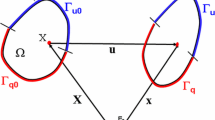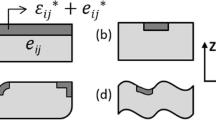Abstract
Residual stress is the stress present in the unloaded equilibrium configuration of a body. Because residual stresses can significantly affect the mechanical behavior of a component, the measurement of these stresses and the prediction of their effect on mechanical behavior are important objectives in many engineering problems. Common methods for the measurement of residual stresses include various destructive experiments in which the body is cut to relieve the residual stress. The resulting strain is measured and used to approximate the original residual stress in the intact body. In order to predict the mechanical behavior of a residually stressed body, a constitutive model is required that includes the influence of the residual stress.
In this paper we present a method by which the data obtained from standard destructive experiments can be used to derive constitutive equations that describe the mechanical behavior of elastic residually stressed bodies. The derivation is based on the idea that for each infinitesimal neighborhood in a residually stressed body, there exists a corresponding stress free configuration. We refer to this stress free configuration as the ‘virtual’ configuration of the infinitesimal neighborhood. The derivation requires that the constitutive equation for the stress free material be known and invertible; it is used to relate the residual stress to the deformation of the virtual configuration into the residually stressed configuration. Although the concept of the virtual configuration is central to the derivation, the geometry of this configuration need not be determined explicitly, and it need not be achievable experimentally, in order to construct the constitutive equation for the residually stressed body.
The general mathematical forms of constitutive equations valid for residually stressed elastic materials have been derived previously for a number of cases. These general forms contain numerous unknown material-response functions or material constants that must be determined experimentally. In contrast, the method presented here results in a constitutive equation that is an explicit function of residual stress and includes only the material parameters required to describe the stress free material.
After presenting the method for the derivation of constitutive equations, we explore the relationship between destructive experiments and the theory used in the derivation. Specifically, we discuss the use of the theory to improve the design of destructive experiments, and the use of destructive experiments to obtain the data required to construct the constitutive equation for a particular material.
Similar content being viewed by others
References
R.M. Fisher and J.Z. Duan, Influence of substrate on cracking of vapour-deposited thin films due to residual stress. In: B.M. DeKoven, A.J. Gellman and R. Rosenberg (eds),Interfaces Between Polymers, Metals, and Ceramics: materials Research Society Symposium Proceedings. Materials Research Society (1989) pp. 299–304.
H. Nagayoshi, H. Morinaka, K. Kamisako, K. Kuroiwa, T. Shimada and Y. Tarui, Residual stress of a-Si1-xNx: H films prepared by afterglow plasma chemical vapor deposition technique.Japanese Journal of Applied Physics 13 (Part 2) (1992) L867-L869.
H.T. Hahn, Residual stresses in polymer matrix composite laminates.Journal of Composite Materials 10 (1976) 266–278.
R. Tandon and D.J. Green, The effect of crack growth stability induced by residual compressive stresses on strength variability.Journal of Materials Research 7 (1992) 765–771.
T.A. Harris, M.A. Ragen and R.F. Spitzer, The effect of hoop and material residual stresses on the fatigue life of high speed rolling bearings.Tribology Transactions 35 (1992) 194–198.
Y.C. Fung,Biomechanics: Motion, Flow, Stress, and Growth. Springer-Verlag (1990).
J.M. Guccione, A.D. McCulloch and L.K. Waldman, Passive material properties of intact ventricular myocardium.ASME Biomech. Eng. 113 (1991) 42–55.
V. Hauk, P. Holler and E. Macherauch, Measuring techniques of residual stresses — present situation and future aims. In: E. Macherauch and V. Hauk (eds),Residual Stresses in Science and Technology. DGM Informationsgesellschaft (1987) pp. 231–242.
G.A. Matzkanin, Nondestructive evaluation of residual stress in composites and advanced materials: a state-of-the-art review. In: E. Macherauch and V. Hauk (eds),Residual Stresses in Science and Technology. DGM Informationsgesellschaft (1987) pp. 101–108.
E. Macherauch and K.H. Kloos, Origin, measurement and evaluation of residual stresses. In: E. Macherauch and V. Hauk (eds),Residual Stresses in Science and Technology. DGM Informationsgesellschaft (1987) pp. 3–26.
B.E. Johnson and A. Hoger, The dependence of the elasticity tensor on residual stress.Journal of Elasticity 33 (1993) 145–165.
A.L. Cauchy, Sur l'equilibre et le mouvement interieur des corps consideres comme des masses continues.Ex. de Math 4 (1829) 293–319.
A. Hoger, On the determination of residual stress in an elastic body.Journal of Elasticity 16 (1986) 303–324.
R.S. Marlow, On the stress in an internally constrained elastic material.Journal of Elasticity 27 (1992) 97–131.
A. Hoger, Residual stress in an elastic body: a theory for small strains and arbitrary rotations.Journal of Elasticity 31 (1993) 1–24.
A. Hoger, The constitutive equation for finite deformations of a transversely isotropic hyperelastic material with residual stress.Journal of Elasticity 33 (1993) 107–118.
A. Hoger, The elasticity tensor of a transversely isotropic hyperelastic material with residual stress.Journal of Elasticity (in press).
M.E. Gurtin,Introduction to Continuum Mechanics. Academic Press (1984).
K. Taiamizawa and T. Matsuda, Kinematics for bodies undergoing residual stress and its applications to the left ventricle.Journal of Applied Mechanics 57 (1990) 321–329.
K. Hayashi and K. Taiamizawa, Stress and strain distributions and residual stresses in arterial walls. In: Fung, Hayashi and Seguchi (eds),Progress and New Directions in Biomechanics. Mita Press (1989).
R.S. Rivlin and D.W. Saunders, Large elastic deformations of isotropic materials VII. Experiments on the deformation of rubber.Phil. Trans. Roy. Soc. A243 (1951) 251–288.
R.S. Rivlin, A uniqueness theorem in the theory of highly-elastic materials.Proc. Cambridge Phil. Soc. 44 (1948) 595–597.
C. Truesdell and W. Noll, The non-linear field theories of mechanics.Handbuch der Physik III/3. Springer-Verlag (1965).
J.L. Ericksen, Inversion of a perfectly elastic spherical shell.Z. angew. Math. Mech. 35 (1955) 382–385.
P.C. Chen and Y. Oshida, Residual stress analysis of a multi-layer thin film structure by destructive (curvature) and non-destructive (X-ray) methods. In: B.M. DeKoven, A.J. Gellman, and R. Rosenberg (eds),Interfaces Between Polymers, Metals, and Ceramics: Materials Research Society Symposium Proceedings. Materials Research Society (1989) pp. 363–368.
W.H. Chu and M. Mehregany, A study of residual stress distribution through the thickness of p+ silicon films.IEEE Transactions on Electron Devices 40 (Number 7) (1993) 1245–1250.
J.H. Omens, H.A. Rockman and J.W. Covell, Passive ventricular mechanics in tight-skin mice.American Journal of Physiology 266 (Number 3 Part 2) (1994) H1169-H1176.
R. Skalak, S. Zargaryan, R.K. Jain, P. Netti and A. Hoger, Compatibility and the genesis of residual stress by volumetric growth.J. Theor. Biology (in press).
J.A. Blume, Compatibility conditions for a left Cauchy-Green strain field.Journal of Elasticity 21 (1989) 271–308.
A. Hoger, On the residual stress possible in an elastic body with material symmetry.Archive for Rational Mechanics and Analysis 88 (Number 3) (1985) 271–289.
M.E. Gurtin, The linear theory of elasticity.Handbuch der Physik VIa/2 Springer-Verlag (1972).
R.D. Cook and W.C. Young,Advanced Mechanics of Materials. Macmillan (1985).
Author information
Authors and Affiliations
Rights and permissions
About this article
Cite this article
Johnson, B.E., Hoger, A. The use of a virtual configuration in formulating constitutive equations for residually stressed elastic materials. J Elasticity 41, 177–215 (1995). https://doi.org/10.1007/BF00041874
Received:
Revised:
Issue Date:
DOI: https://doi.org/10.1007/BF00041874




